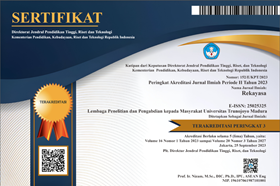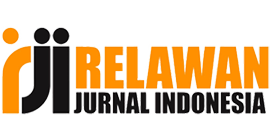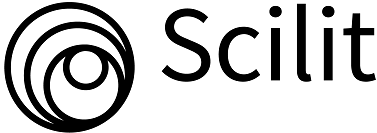Penampilan 10 Kandidat Jagung Hibrida Berdaya Hasil Tinggi dan Toleran terhadap Kekeringan
Abstract
One way to increase maize productivity in dry land is to develop superior maize varieties with high production, early maturity, and resistance to drought stress. The study aims to evaluate the characteristics of 10 hybrid maize candidates with high production, early maturity and resistance to drought stress. The research used a Randomized Complete Block Design (RCBD) with 13 genotypes (10 hybrid maize candidates, three comparison varieties (Jakaring, Pioneer-X, and Bisi-X)) as treatments. It was repeated three times, so that there were 39 experimental units. Drought stress using the CYMMYT method, namely drought stress, is carried out when the plants are 50 DAP until harvest, but providing irrigation with field capacity at 0 to 40 DAP with an interval of every 10 days. The observation parameters in this study were plant height, number of leaves, leaf length, leaf area, ear height, days of 50% tasseling, days to 50% silking, harvest age, number of kernel rows, weight of cob with husk, ear length, ear diameter, kernel width, kernel length, kernel thickness, kernel diameter, 1000-kernel weight, and production per hectare. The results of the study showed that the thirteen tested characters showed a very significant effect of the treatment, namely plant height, number of leaves, leaf length, leaf area, ear height, days of 50% tasseling, days to 50% silking, harvest age, number of kernel rows, weight of cob with husk, ear length, kernel width, and 1000-kernel weight. Four characters showed a significant effect of treatment: kernel length, kernel thickness, kernel diameter, and production per hectare. The ear diameter character did not show any significant differences between treatments. The broad heritability values for all tested characters for the 13 genotypes ranged from 49.90 to 97.90. Production per hectare was positively correlated with ear length (0.79**), ear diameter (0.37*), and kernel thickness (0.59**). Furthermore, the production character per hectare is negatively correlated with harvest age (-0.49**) and kernel length (-0.38*). G1, G2, G3, and G6 are the hybrid maize candidates selected for the release of hybrid varieties with high production and early maturity.
Keywords
Full Text:
PDF (Bahasa Indonesia)References
Amzeri, A. (2018). Overview of the Development of Maize Farming in Madura and Alternative Processing into Biomaterials. Rekayasa, 11(1), 74. https://doi.org/10.21107/rekayasa.v11i1.4127
Amzeri, A., Adiputra, F., & Khoiri, S. (2024). Selection of Maize Hybrids Resulting from Line × Tester Crossing Tolerant to Drought Stress. Journal of Global Innovations in Agricultural Sciences, 575–584. https://doi.org/10.22194/jgias/24.1326
Amzeri, A., Badami, K., Santoso, S. B., & Sukma, K. P. (2022). Morphological and molecular characterization of maize lines tolerance to drought stress. Biodiversitas, 23(11), 5844–5853. https://doi.org/10.13057/biodiv/d231138
Amzeri, A., Suhartono, Fatimah, S., Pawana, G., & Sukma, K. P. W. (2024). COMBINING ABILITY ANALYSIS IN MAIZE DIALLEL HYBRID POPULATIONS UNDER OPTIMUM AND DROUGHT STRESS CONDITIONS. Sabrao Journal of Breeding and Genetics, 56(2), 476–492. https://doi.org/10.54910/sabrao2024.56.2.3
Azrai, M. (2013). Jagung Hibrida Genjah: Prospek Pengembangan Menghadapi Perubahan Iklim. Itek Tanaman Pangan, 8(2), 90–96.
BPS. (2025). Luas Panen, Produksi, dan Produktivitas Jagung Menurut Provinsi. Https://Www.Bps.Go.Id/Id/Statistics-Table/2/MjIwNCMy/Luas-Panen--Produksi--Dan-Produktivitas-Jagung-Menurut-Provinsi.Html.
Dinas Pertanian Tanaman Pangan Holtikultura dan Perkebunan Bangkalan. (2021). Data Produksi Jagung Di Kabupaten Bangkalan Tahun 2017-2020.
Firmansyah, R. I., Yulianah, I., & Kuswanto. (2021). Evaluasi Keragaman Pada Populasi F2 Tanaman Kecipir (Psophocarpus tetragonolobus L.) Evaluation Of Variability In F2 Population Of Winged Bean (Psophocarpus tetragonolobus L.). Jurnal Produksi Tanaman, 9(12), 692–700.
Fitriana, A., Hanani, N., & Fahriyah, F. (2024). Dampak Kebijakan Domestik Terhadap Produski Dan Harga Jagung Domestik Di Indonesia. Jurnal Ekonomi Pertanian Dan Agribisnis, 8(3), 1077–1089. https://doi.org/10.21776/ub.jepa.2024.008.03.21
Hallauer, A. R., Carena, M. C., & Filho, J. B. M. (2010). Quantitative Genetics in Maize Breeding. Springer.
Kartahadimaja, J., Utomo, S. D., Yuliadi, E., Salam, A. K., Warsono, & Wahyudi, A. (2021). Agronomic characters, genetic and phenotypic diversity coefficients, and heritability of 12 genotypes of rice. Biodiversitas, 22(3), 1091–1097. https://doi.org/10.13057/biodiv/d220302
Khan, A. A., Wang, Y. F., Akbar, R., & Alhoqail, W. A. (2025). Mechanistic insights and future perspectives of drought stress management in staple crops. In Frontiers in Plant Science (Vol. 16). Frontiers Media SA. https://doi.org/10.3389/fpls.2025.1547452
Mulyani, A., & Sarwani, M. (2013). The Characteristic and Potential of Sub Optimal Land for Agricultural Development in Indonesia. Jurnal Sumberdaya Lahan, 7(1), 46–57.
Nurahman, I. S., Sudrajat, & Noor, T. I. (2021). Struktur Pendapatan Petani Jagung di Desa Karangpari Kecamatan Rancah Kabupaten Ciamis. Agricore: Jurnal Agribisnis Dan Sosial Ekonomi Pertanian, 6(2), 193202.
Oguz, M. C., Aycan, M., Oguz, E., Poyraz, I., & Yildiz, M. (2022). Drought Stress Tolerance in Plants: Interplay of Molecular, Biochemical and Physiological Responses in Important Development Stages. Physiologia, 2(4), 180–197. https://doi.org/10.3390/physiologia2040015
Ortez, O. A., Lindsey, A. J., Thomison, P. R., Coulter, J. A., Singh, M. P., Carrijo, D. R., Quinn, D. J., Licht, M. A., & Bastos, L. (2023). Corn response to long-term seasonal weather stressors: A review. Crop Science, 63(6), 3210–3235. https://doi.org/10.1002/csc2.21101
Prasetyo, R., Kartika Sari, M., & Kurnia Lestari, Y. (2024). Penguatan Ekosistem Jagung: Isu, Tantangan, Kebijakan (Vol. 6, Issue 1).
Priyanto, S. B., Effendi, R., & Zainuddin, B. (2023). Genetic variability , heritability , and path analysis for agronomic characters in hybrid maize. Jurnal Kultivasi, 22(1), 26–35. https://doi.org/http://dx.doi.org/10.24198/kultivasi.v22i1.38807
Schmidt, P., Hartung, J., Bennewitz, J., & Hans-Peter, P. (2019). Heritability in plant breeding on a genotype-difference basis. Genetics, 212(4), 991–1008. https://doi.org/10.1534/genetics.119.302134
Syauqi, A. H., & Amzeri, A. (2023). Seleksi Tanaman Jagung Toleran pada Cekaman Kekeringan. Rekayasa, 16(1), 113–124. https://doi.org/10.21107/rekayasa.v16i1.20906
Walpole, R. E. (1982). Introduction of Statistic (3rd Edition). MacMilan Publishing Company.
Weber, V. S., Melchinger, A. E., Magorokosho, C., Makumbi, D., Bänziger, M., & Atlin, G. N. (2012). Efficiency of managed-stress screening of elite maize hybrids under drought and low nitrogen for yield under rainfed conditions in Southern Africa. Crop Science, 52(3), 1011–1020. https://doi.org/10.2135/cropsci2011.09.0486
Yang, Z., Cao, Y., Shi, Y., Qin, F., Jiang, C., & Yang, S. (2023). Genetic and molecular exploration of maize environmental stress resilience: Toward sustainable agriculture. In Molecular Plant (Vol. 16, Issue 10, pp. 1496–1517). Cell Press. https://doi.org/10.1016/j.molp.2023.07.005
Zaidi, P. H., Thayil Vinayan, M., Nair, S. K., Kuchanur, P. H., Kumar, R., Bir Singh, S., Prasad Tripathi, M., Patil, A., Ahmed, S., Hussain, A., Prabhakar Kulkarni, A., Wangmo, P., Tuinstra, M. R., & Prasanna, B. M. (2023). Heat-tolerant maize for rainfed hot, dry environments in the lowland tropics: From breeding to improved seed delivery. Crop Journal, 11(4), 986–1000. https://doi.org/10.1016/j.cj.2023.06.008
Zaki, H. E. M., & Radwan, K. S. A. (2022). Estimates of genotypic and phenotypic variance, heritability, and genetic advance of horticultural traits in developed crosses of cowpea (Vigna unguiculata [L.] Walp). Frontiers in Plant Science, 13. https://doi.org/10.3389/fpls.2022.987985
DOI
https://doi.org/10.21107/rekayasa.v18i2.30907Metrics
Refbacks
- There are currently no refbacks.
Copyright (c) 2025 Ach Rofiqi Ramlan

This work is licensed under a Creative Commons Attribution-ShareAlike 4.0 International License.
























